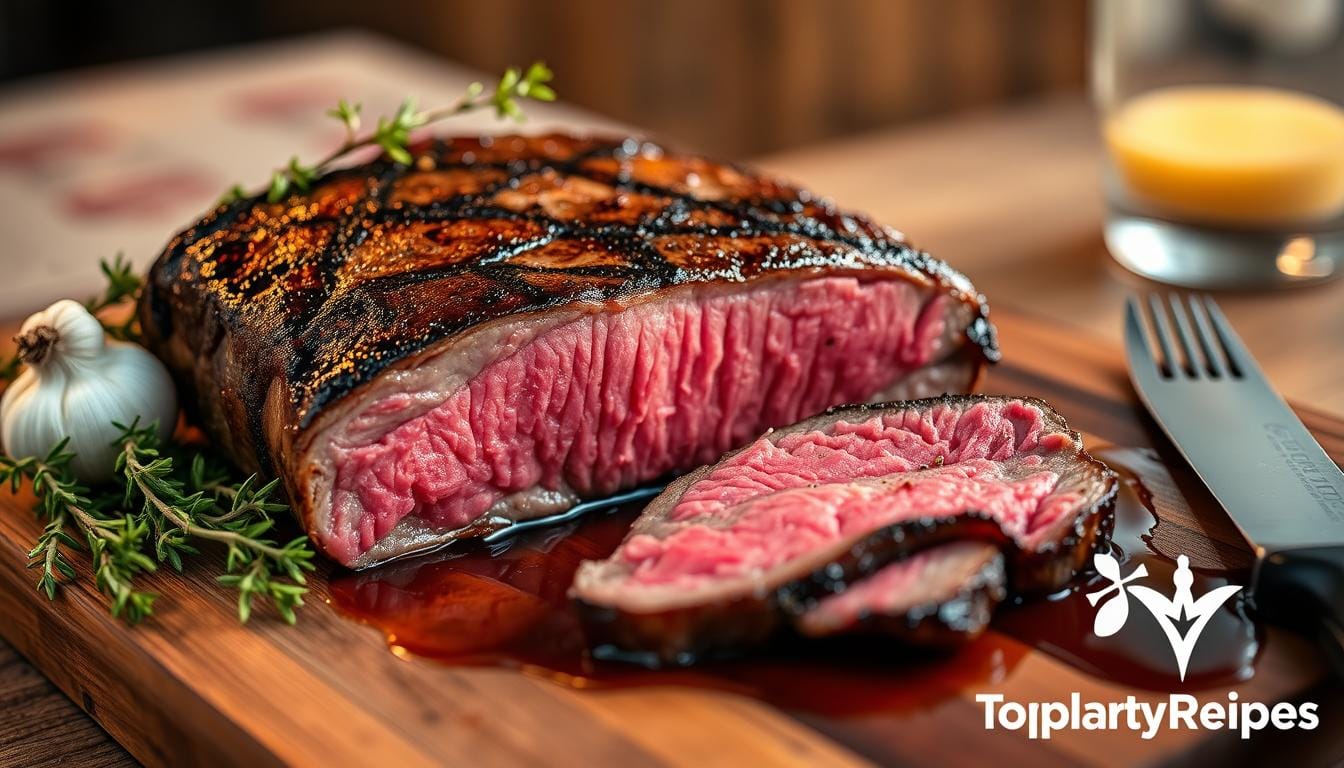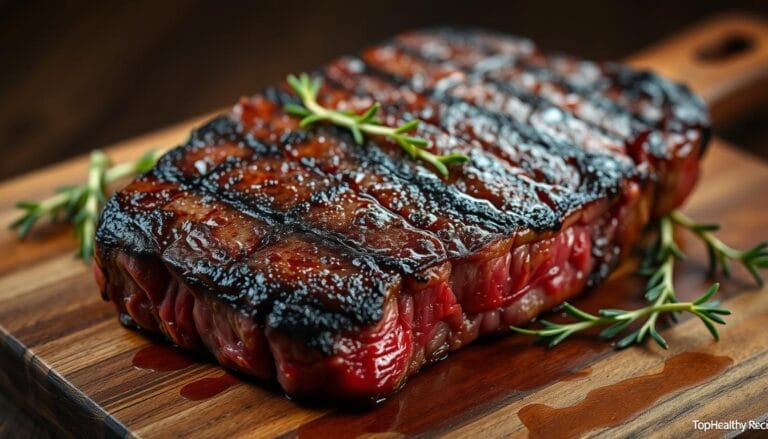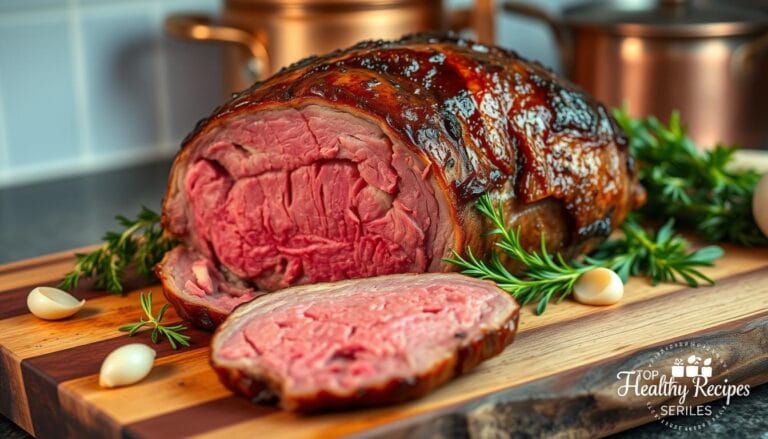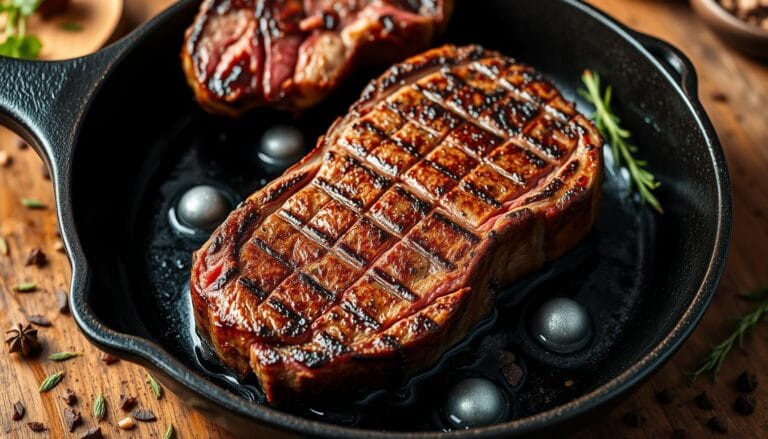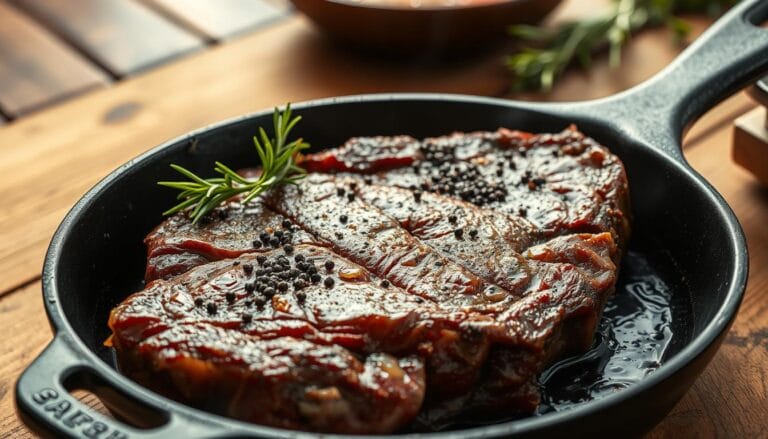Juicy New York Strip Steak Recipe for the Perfect Restaurant Taste
Table of Contents
Juicy New York Strip Steak Recipe for the Perfect Restaurant Taste
There’s something magical about that first bite of a perfectly cooked steak. The crisp, caramelized crust gives way to tender, juicy meat. You’ve probably tried to recreate that restaurant magic at home, but it often ends up chewy or overcooked. We’ve all been there.
But what if you could master a foolproof method to turn your kitchen into a steakhouse? This guide isn’t just about following steps. It’s about understanding why certain techniques work.
Choosing the right cut is important, but so is how you season, sear, and let it rest. You’ll learn how to spot quality marbling at the grocery store. You’ll also find out why a cast-iron skillet is your best friend and how timing impacts every juicy result.
Imagine serving a steak that rivals your favorite upscale restaurant’s menu. No fancy tools or vague instructions. Just clear, tested strategies for nailing that golden-brown exterior and pink center. Ready to transform your next dinner?
Key Takeaways
- Selecting high-quality meat with visible marbling ensures flavor and tenderness
- Proper seasoning enhances natural flavors without overpowering the steak
- A cast-iron skillet delivers the ideal sear for a restaurant-style crust
- Resting the meat after cooking locks in juices for maximum succulence
- Presentation tips elevate your dish from homemade to gourmet
Understanding New York Strip Steak
Before you start cooking, knowing your cut is key. The New York strip steak is loved for its bold taste and flexibility. It’s perfect for those who want to make restaurant-quality meals at home. Let’s explore what makes this cut unique and how to choose the best one for your New York strip steak recipe.
What Is a New York Strip Steak?
This steak comes from the short loin, just behind the ribs. It’s famous for its rich beef flavor and firm texture. Unlike fattier cuts, the strip steak has just the right amount of fat. This fat melts during cooking, keeping the meat juicy and flavorful.
Cut and Characteristics
A good New York strip has a crescent-shaped fat cap on one side. This fat cap bastes the meat as it cooks, adding flavor. The leaner side has long muscle fibers, giving the steak its chewy texture. Its thickness (1.5–2 inches) ensures even cooking and a perfect sear.
Choosing the Right Steak
Look for USDA grades on the label:
- Prime: Highest marbling – best for high-heat methods
- Choice: Moderate fat – great for most home kitchens
- Select: Leaner – requires careful cooking to avoid dryness
Press the steak gently. It should feel firm but spring back slightly. Avoid grayish hues or excessive liquid in the package. For your New York strip steak recipe, thicker cuts (over 1.5 inches) give you more control over doneness.
Essential Ingredients for Your Recipe
Great ingredients make good steaks unforgettable. Whether grilling or pan-searing, the right stuff makes your New York strip restaurant-worthy. Here’s what you need for perfect flavor and texture.
Fresh Ingredients You’ll Need
Start with these six essentials for your New York strip steak recipe:
- 1.5-inch thick New York strip steak (12-16 oz for two servings)
- Kosher salt (coarse grains for better crust formation)
- Freshly cracked black pepper
- Unsalted butter (high-fat European-style preferred)
- Fresh garlic cloves (4-5, lightly crushed)
- Rosemary sprigs (2-3 for aromatic basting)
For gourmet upgrades, try truffle salt flakes or smoked paprika. These add depth without overpowering the steak’s natural richness.
Recommended Seasonings
Keep it simple but impactful:
“Salt amplifies flavor, pepper adds complexity – let the steak speak for itself.”
- 1.5 tsp kosher salt per pound of meat
- 1 tsp freshly ground black pepper
- Optional: ½ tsp garlic powder for extra savoriness
Dry brining works wonders here. Salt the steak 1-2 hours before cooking to enhance tenderness and moisture retention.
Optional Marinades
While purists prefer dry seasoning, marinades offer exciting variations. Compare these methods:
| Method | Time | Flavor Impact |
|---|---|---|
| Dry Brine | 1-24 hours | Intensifies natural beef flavor |
| Red Wine Marinade | 2-4 hours | Adds fruity acidity |
Quick Red Wine Marinade:
- Combine ½ cup dry red wine
- 2 tbsp olive oil
- 3 crushed garlic cloves
- 1 tbsp chopped fresh thyme
Marinate steak 2-4 hours max – any longer and the acid will start breaking down the meat’s texture.
Preparation Steps Before Cooking
Getting the prep work right is key to making restaurant-worthy masterpieces. These steps help ensure even cooking, deep flavor, and that perfect crust everyone loves.
Thawing and Resting the Steak
Thaw frozen steak in the fridge for 24 hours. This slow thawing keeps juices in and bacteria out. After thawing, pat the meat dry and let it rest at room temperature for 30-45 minutes. Cold steak cooks unevenly on high heat.
Preparing the Marinade
Here’s a basic marinade recipe:
- ¼ cup olive oil
- 3 minced garlic cloves
- 1 tbsp rosemary
Marinate for 2-4 hours. Longer times can make the steak mushy. Remove excess marinade before cooking to prevent steaming.
Seasoning the Steak
Use kosher salt 40 minutes before cooking. This helps the steak absorb salt for better flavor. Just before cooking, add pepper and spices like smoked paprika.
| Seasoning Time | Effect on Crust | Juiciness Level |
|---|---|---|
| Immediately Before Cooking | Weak crust formation | Medium |
| 40 Minutes Before | Crispy, caramelized crust | High |
Cooking Methods for New York Strip Steak
There are three top ways to cook a New York strip steak: sizzling pans, oven, and sous vide. Each method has its own benefits. You can get a smoky char, a buttery crust, or perfectly cooked meat. Let’s explore the best ways to cook your steak.
Grilling vs. Pan-Searing
Pan-searing in a cast-iron skillet gives a delicious crust and keeps the meat juicy. Heat the pan until it’s very hot, then cook the steak for 3–4 minutes on each side. For thicker steaks, finish cooking in a 400°F oven for 5–7 minutes.
To reduce smoke, use avocado oil and baste with butter in the last minute. This makes the steak taste amazing.
Oven-Baked Technique
Baking a new york strip in oven is great for thicker steaks. Preheat to 275°F and cook on a wire rack for 20–25 minutes until it’s 120°F inside. Let it rest for 10 minutes, then quickly sear it in a hot pan.
This method helps avoid overcooking and ensures a perfect crust.
Sous Vide for Perfect Doneness
Vacuum-seal the steak and cook it in a 129°F water bath for 1–2 hours. Dry the meat and sear it in a very hot pan for 60 seconds on each side. Sous vide makes sure the steak is perfectly cooked all the way through.
| Method | Best For | Temp Guide | Total Time |
|---|---|---|---|
| Pan-Searing | Quick meals, crust lovers | Medium-high heat | 10–12 mins |
| Oven-Baked | Thick cuts, even cooking | 275°F (oven) | 30–35 mins |
| Sous Vide | Precision, tender results | 129°F (water bath) | 1.5–2.5 hrs |
Ideal Cooking Temperatures
Mastering temperatures makes your New York strip steak truly gourmet. Getting it right brings out the steak’s natural flavors and keeps it juicy. Here’s how to hit the perfect temperature every time.
Medium Rare vs. Medium
For a New York strip steak recipe, aim for medium rare (130–135°F). This temperature gives you a seared crust and a warm, pink center. Medium (140–145°F) is slightly less red but just as tender. Here’s a quick guide:
| Doneness | Remove from Heat | Final Temp After Resting |
|---|---|---|
| Rare | 120°F | 125°F |
| Medium Rare | 130°F | 135°F |
| Medium | 140°F | 145°F |
Using a Meat Thermometer
Don’t guess the doneness. Use a thermometer. Stick the probe into the steak’s thickest part, avoiding bones or fat. Digital thermometers give you an instant read. This is key for getting the exact moment to remove your steak from the heat.
Resting the Steak After Cooking
Resting is essential. It lets juices redistribute, raising the internal temperature by about 5°F. Cover the steak loosely with foil for 5–10 minutes. This step turns a good steak into a buttery, melt-in-your-mouth delight. Skipping it can lose up to 30% of those precious juices.
Adding Flavor with Sides
A perfectly cooked New York Strip steak needs great sides and sauces. The right choices make your meal special. They balance the rich beef with fresh and tasty options.
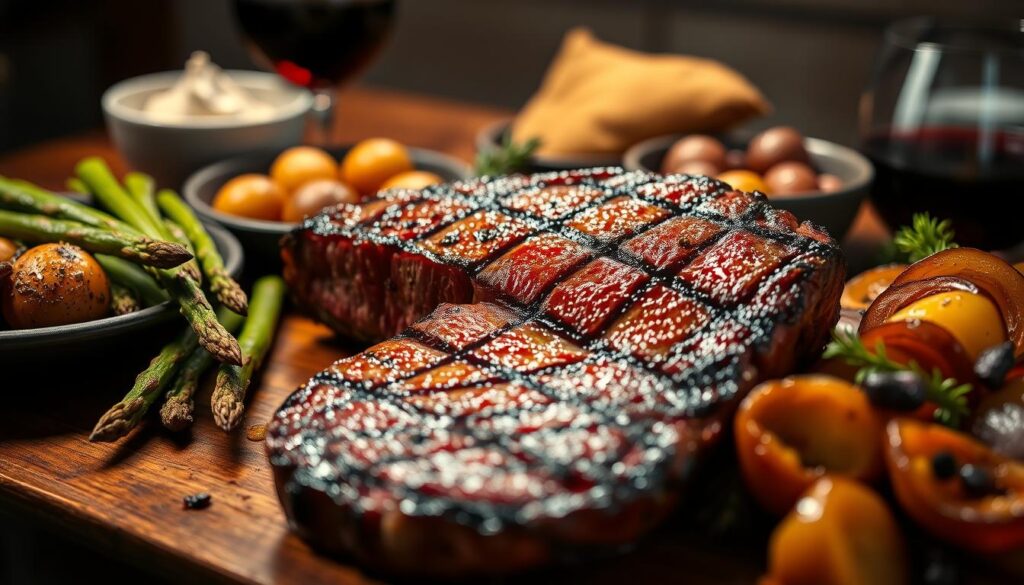
Perfect Pairings for New York Strip
Classic pairings are always a hit. Garlic mashed potatoes offer a creamy contrast. Roasted asparagus adds a fresh, earthy touch. For a surf-and-turf twist, try garlic butter shrimp with your steak.
“A great sauce can turn good steak into unforgettable steak – it’s the final touch.”
Popular Side Dishes
Try mixing old favorites with new ideas:
- Crispy smashed potatoes with rosemary
- Charred broccolini with lemon zest
- Truffle mac and cheese (for a special treat)
| Side Dish | Prep Time | Flavor Profile |
|---|---|---|
| Grilled mushrooms | 15 mins | Umami-rich |
| Creamed spinach | 20 mins | Velvety & savory |
| Hasselback potatoes | 45 mins | Crispy & buttery |
Complementary Sauces
Choose sauces that enhance your steak without overpowering it:
- Bold choices: Chimichurri (herb-forward) or peppercorn sauce
- Lighter options: Lemon-herb butter or balsamic glaze
Quick Red Wine Reduction: Simmer 1 cup cabernet with 2 tbsp butter and 1 tsp honey until thick. Drizzle over your steak.
Tips for Achieving Restaurant Quality
To make your steakhouse-quality New York strip at home, focus on three key areas. First, choose the best ingredients. Next, control the heat precisely. Lastly, use professional searing methods to take your steak to the next level.
Marbling and Quality Cuts
Fat equals flavor when cooking New York strip steak. Look for USDA Prime or Choice grades with visible white streaks. These fat pockets melt during cooking, adding:
- Rich, buttery texture
- Enhanced juiciness
- Natural self-basting effect
Butcher John Harper advises:
“A well-marbled steak needs minimal seasoning – let the meat speak for itself.”
Using High Heat
Preheat your pan or grill to 450°F minimum for the Maillard reaction. This chemical process creates the delicious crust. Here’s a heat checklist:
- Cast iron skillet: 5-minute preheat
- Gas grill: 15-minute lid-down preheat
- Charcoal: Wait for white-hot embers
Pro tip: Test heat by sprinkling water droplets – they should vaporize instantly without sizzling.
Searing Techniques
Master the “press and release” method for even crust development:
- Place steak in scorching-hot pan
- Press firmly for 10 seconds
- Release completely
- Repeat after each flip
This technique maximizes surface contact while preventing moisture loss. Flip every 60 seconds using tongs – never pierce the meat with forks.
Common Mistakes to Avoid
Even experienced cooks can mess up a New York strip steak with simple mistakes. These errors can make a big difference between a home-cooked meal and a restaurant-quality dish. Let’s look at the top mistakes and how to avoid them.
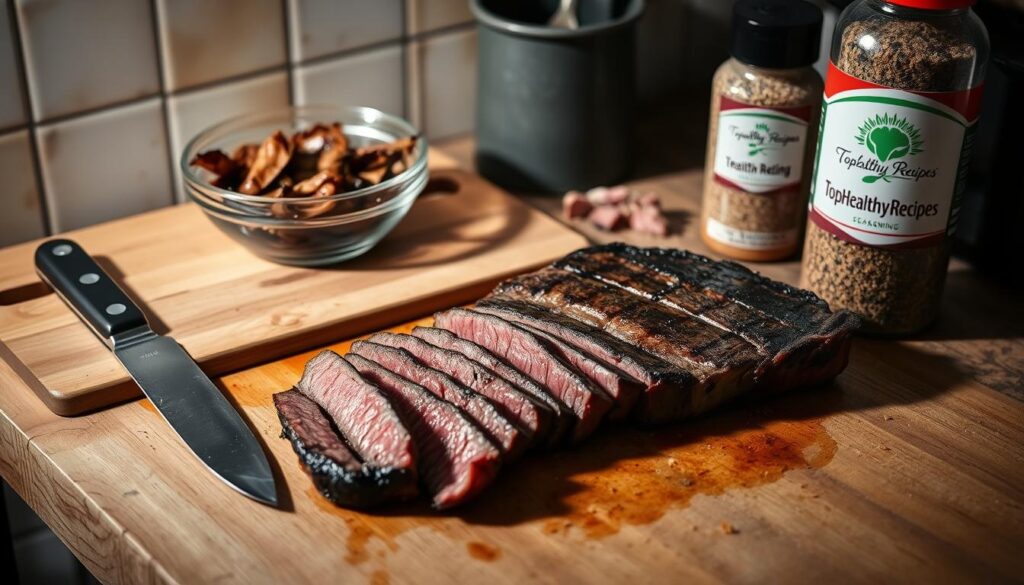
Overcooking the Steak
Poking the steak while cooking can make it dry. Each fork prick lets juices out. Use tongs to flip it and a meat thermometer for the right temperature.
If your steak is overcooked, don’t worry. Drizzle au jus or beef broth over it to add moisture. This makes it taste like it was cooked just right.
Skipping the Resting Period
Cutting into your steak right away is a big mistake. The 5–10 minutes of resting let juices spread out evenly. Without this, your steak will lose its flavor.
To get the best results, cover the steak with foil during resting. This keeps it warm without making the crust soft.
Wrong Seasoning Choices
Iodized table salt can ruin your steak. Its bitter taste doesn’t match beef’s richness. Use coarse kosher salt or flaky sea salt for better flavor.
Another mistake is overcrowding the pan. Steaks need space to sear, not steam. Cook in batches if you have to, so each steak can get that perfect crust.
How to Serve Your New York Strip Steak
Presentation and technique make a great steak even better. Whether you’re serving guests or enjoying it yourself, these tips will make every bite a delight.
Slicing Techniques
Always slice your New York strip against the grain for tenderness. Look for parallel muscle fibers, then cut them at a 90-degree angle. For juicier slices, angle your knife at 45 degrees.
- Let the steak rest 5–7 minutes before slicing.
- Use a carving knife for clean cuts.
- Arrange slices slightly overlapping for visual appeal.
Presentation Tips
Think of your plate as a canvas. Wooden boards bring a rustic feel, while white porcelain highlights the steak’s sear. Add color with sides like garlic butter asparagus or roasted cherry tomatoes. Top with fresh thyme or rosemary for a professional look.
Recommended Serving Styles
Pair your steak with bold red wines like Cabernet Sauvignon or Malbec. For a modern twist, try these:
- Classic Steakhouse: Serve with loaded mashed potatoes and creamed spinach
- Fusion Style: Top with ginger-scallion butter (inspired by how to make hibachi steak)
- Minimalist: Focus on the steak alone with flaky sea salt on the side
Storing Leftover Steak
Leftover New York strip steak can stay delicious if stored right. Whether you cooked it in the oven or on the grill, these tips will help. They ensure your steak stays tender and safe to eat. Let’s explore how to keep your meal fresh and find new ways to enjoy it.
Proper Refrigeration Techniques
Cool your steak to room temperature within 2 hours of cooking. Wrap it tightly in foil or plastic wrap, then put it in an airtight container. Refrigerated steak stays fresh for 3–4 days, while frozen cuts last up to 3 months. For best results, label containers with dates to track freshness.
Reheating Without Drying Out
Reheat your New York strip in the oven at 250°F. Add a splash of beef broth to the baking dish to keep it moist. Cover the steak with foil and warm it for 15–20 minutes, checking the internal temperature with a meat thermometer (aim for 120–125°F). This method keeps the steak juicy, just like sous vide.
Creative Ways to Use Leftovers
Transform yesterday’s steak into today’s main attraction. Try these ideas:
- Steak Tacos: Slice thinly, toss with spices, and pair with fresh salsa.
- Philly Cheesesteak Sandwiches: Sauté onions and peppers, layer with steak, and melt provolone on top.
- Steak Salad: Combine mixed greens, cherry tomatoes, and blue cheese crumbles for a hearty lunch.
Leftover steak is also great in fried rice or breakfast hash. The key is to slice against the grain for tenderness, just like when serving it fresh.
Conclusion: Enjoying Your Perfect Steak
Creating the perfect new york strip steak recipe is all about the details. Start with top-quality cuts and season them well. Then, cook at precise temperatures. Letting the meat rest is key to keeping juices in for a tender bite.
Key Steps to Remember
Season your steak with coarse salt and cracked pepper before cooking. Use high heat for a crispy crust, whether grilling or pan-searing. Check the steak’s doneness with a meat thermometer—130°F for medium rare. Let it rest for 5-7 minutes before slicing against the grain.
Elevate Your Presentation
Enhance your steak with garlic butter or a red wine reduction. Serve it with roasted asparagus, truffle fries, or creamy mashed potatoes. Add fresh herbs like rosemary or thyme for a nice touch.
Share the Flavor
Share your steak with friends or family. Host a steak night with unique marinades or rubs. Try smoked paprika or espresso blends. Leftovers are great for steak tacos or salads the next day.
Ready to wow your guests? Fire up the grill or skillet and try this new york strip steak recipe tonight. Share your creations online with #PerfectStripSteak and inspire others!
FAQ
What’s the best way to cook a New York strip steak on the stove?
How do I cook a New York strip steak in the oven?
What’s the ideal thickness for a New York strip steak?
Should I marinate a New York strip steak?
How do I prevent my steak from smoking while pan-searing?
What internal temperature should I target for medium-rare?
Can I use a grill instead of a pan for New York strip steak?
How do I reheat leftover New York strip without drying it out?
What sides pair best with New York strip steak?
Why is my New York strip steak tough?
For more cooking tips, stay connected with us. We also recommend the cookbook Skinnytaste Simple: Easy, Healthy Recipes with 7 Ingredients or Fewer
For more Recipes about Steak ?
Did You try our recipe ?
There are no reviews yet. Be the first one to write one.
